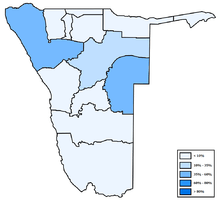Herero language
| Herero | |
|---|---|
| Otjiherero | |
| Native to | Namibia, Botswana, Angola |
| Region | Kunene, Omaheke Region and Otjozondjupa Region in Namibia; Ghanzi in Botswana; Namibe, Huíla and Cunene in Angola |
| Ethnicity | Herero, Himba, Mbanderu, Tjimba, Kwisi, Twa |
Native speakers | 240,000 incl. Hakaona, ca. 270,000 incl. Zemba (2006)[1] |
| Dialects | |
| Language codes | |
| ISO 639-1 |
hz |
| ISO 639-2 |
her |
| ISO 639-3 |
her |
| Glottolog |
here1253[2] |
R.30 (R31,311,312); R.101 (Kuvale)[3] | |
|
The disparate distribution of the Herero language in Namibia, showing the concentration of Herero speakers on the Kalahari boundary in the east, as well as the outlying Herero-speaking Himba people of the Kaokoveld in the far north-west. | |
| Herero | |
|---|---|
| Person | Omuherero |
| People | Ovaherero |
| Language | Otjiherero |
The Herero language (Helelo, Otjiherero) is a language of the Bantu subfamily of the Niger–Congo group. It is spoken by the Herero and Mbanderu peoples in Namibia (206,000) and Botswana, as well as by small communities of this people in southwestern Angola. There are a quarter million speakers.[1]
Overview
Its linguistic distribution covers a zone called Hereroland: this zone is constituted of the region of Omaheke, along with the Otjozondjupa and Kunene Regions. The Himba people, who are related to the Herero and Mbanderu, speak a dialect very close to Otjiherero. A considerable minority of Herero speakers live in Windhoek, the capital of Namibia.
Because of missionary Gottlieb Viehe's (1839–1901) translation of the Bible into Herero at the end of the 19th century, the spoken language was transcribed to an alphabet based on the Latin script. Father Peter Heinrich Brincker (1836–1904) translated several theological works and songs.
Otjiherero is taught in Namibian schools both as a native tongue and as a secondary language. It is included as a principal material at the University of Namibia. Otjiherero is also one of the six minority languages that are used by the Namibian State Radio (NBC). Gamsberg Macmillan, as of 2008, has published the only dictionary in Otjiherero.
The Hakaona variety is now considered a separate Bantu language, as sometimes is Zemba (Otjizemba).[4] Maho (200) also removes Kuvale to Bantu Zone R.10, while differentiating North-West Herero (Kaokoland Herero, including Zemba and presumably Himba and Hakaona), R.311, and Botswana Herero (including Mahalapye Herero), R.312, as distinct from but closely related to Herero proper. Within Herero proper, he recognizes two dialects, Central Herero and Mbandero (East Herero). Northwest/Zemba is found on either side of the Namibian–Angolan border. Central Herero covers a large area in central Namibia, with East Herero a few islands to the east but still in Namibia. Botswana Herero consists of a few scattered islands in Botswana, with about 15% the population of Herero proper.[3] Ethnologue separates Zimba as a distinct language, but retains Himba, East Herero and Botswana Herero within the Herero language. However, it no longer recognizes Kuvale as a dialect.[5] This has not yet been designated as a separate language, nor as a dialect affiliated with another language.
Bibliography
- Brincker, Peter Heinrich (1886, 1964). Wörterbuch und kurzgefasste Grammatik des Otji-Herero. Leipzig (reprint 1964 Ridgwood, NJ: The Gregg Press).
- Hahn, C. Hugo (1857). Grundzüge einer Grammatik des Hereró. Berlin: Verlag von Wilhelm Hertz.
- Lutz, Marten (2006). "Locative inversion in Otjiherero: more on morpho-syntactic variation in Bantu." In: Laura Downing, Lutz Marten & Sabine Zerbian (eds.), Papers in Bantu Grammar, ZAS Papers in Linguistics 43, 97—122.
- Marten, Lutz & Nancy C. Kula (2007). "Morphosyntactic co-variation in Bantu: two case studies." SOAS Working Papers in Linguistics 15.227-238.
- Möhlig, Wilhelm, Lutz Marten & Jekura U. Kavari (2002). A Grammatical Sketch of Herero (Otjiherero). Köln: Köppe (Grammatische Analysen afrikanischer Sprachen; v.19).
References
- 1 2 Herero at Ethnologue (18th ed., 2015)
- ↑ Hammarström, Harald; Forkel, Robert; Haspelmath, Martin; Bank, Sebastian, eds. (2016). "Herero". Glottolog 2.7. Jena: Max Planck Institute for the Science of Human History.
- 1 2 Jouni Filip Maho, 2009. New Updated Guthrie List Online
- ↑ Bantu Classification, Ehret, 2009.
- ↑ Compare
Herero language at Ethnologue (15th ed., 2005)
with
Herero language at Ethnologue (16th ed., 2009)
External links
| Herero language test of Wikipedia at Wikimedia Incubator |
